Abstract
Summer squash is one of major winter market fresh vegetables in Miami-Dade County with approximately 6,000 acres a year. Variety selection, land preparation, soil and water management, and effective control of insects and diseases are important for successful production. This article is to elucidate the crop production, market available varieties or cultivars, soil and water management, common diseases and their control, and the management of dominant insects, soil nematodes and weeds. It is anticipated that this publication will provide fundamental information to local vegebable growers, stakeholders, and anyone else interested in successfully growing summer squash.
Situation
Summer squash is an important vegetable crop in Miami-Dade County (Figure 1). Summer squash is grown annually on about 6,000 acres and sold nationwide during the winter in the fresh market. Production costs range from $14.51 to $11.47 per bushel or $4,353 to $5,162/acre for an acceptable yield of 300 to 450 ($9.67 to 17.20/bushel), 42-pound bushels/acre, respectively.
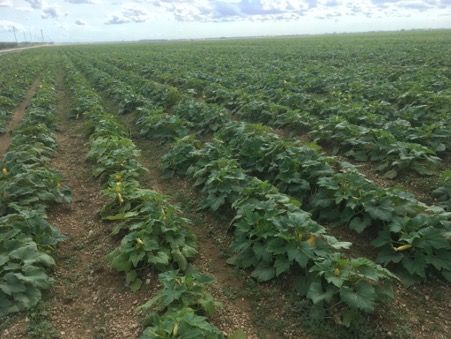
Credit: Qingren Wang, UF/IFAS
Varieties
Table 1. Squash varieties currently grown in the Miami-Dade County.
Soils, Land Preparation, and Transplanting
Squash in Miami-Dade County is usually grown on gravelly soils and occasionally on marl soils. Sandy soils in the west Kendall area are also suitable for squash. Gravelly soils must be a minimum of 6 inches deep, above the bedrock. Periodic rock-plowing increases soil depth. Squash can be planted on flat ground or on raised beds covered with polyethylene film mulch. Squash is relatively sensitive to flooding so there is a risk of losing a squash crop from the flooding of marl soils with high water tables.
The planting season extends from September into February. When squash is planted on flat ground, rows are spaced 36 inches apart; plants within the row are spaced 10–15 inches apart. Typically, raised squash beds are 36–40 inches wide, 6–8 inches high, and spaced 6 feet between the centers of adjacent beds. Transplanted seedlings should be spaced 10–15 inches apart and set 2–3 inches deep.
Fertilizer
Calibrated soil tests for the calcareous soils of Miami-Dade County are not available at present. Tissue analysis is recommended to determine the nutritional status of the crop. Information on plant tissue analysis for squash is provided below in Tables 2 and 3. The total amount of fertilizer required in Miami-Dade County depends on the variety, soil fertility, and other environmental factors. Pre-planting fertilizer formulas of 6-6-6, 6-3-6, 10-10-10 plus micronutreints, or similar formulas are satisfactory. For squash as the first crop on plastic mulch with drip irrigation, less than one-half of the fertilizer should be applied to the beds prior to planting. Fertigation should be initiated with a 4-0-8 or similar formula 3–4 weeks after transplanting to provide the remaining fertilizer. For squash as second crop on plastic mulch, only inject N and K through fertigation. For squash on flat land, all of the P and 30–40% of N and K should be applied at planting, and the remainder side-dressed in 1 or 2 applications before the vines begin to spread. Magnesium nitrate or sulfate and EDDHA-chelated iron should be applied if deficiency symptoms appear.
Irrigation and Freeze Protection
Irrigation is applied to squash using sprinkler systems such as lateral move/center pivot or big guns. Some growers are using plastic mulch to save irrigation water and suppress weeds (Figure 2). Principles and practices of irrigation management are discussed in Chapter 3 of the Vegetable Production Handbook for Florida https://edis.ifas.ufl.edu/entity/topic/vph.
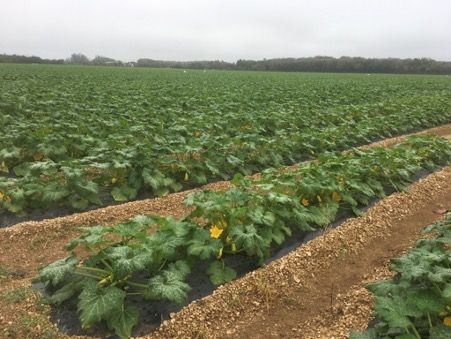
Credit: Qingren Wang, UF/IFAS
For squash on plastic mulch, a drip irrigation system with one drip irrigation tube per bed provides adequate water, although a second tube is beneficial, especially while root systems are small. Water requirements for young plants are low. Irrigation frequencies of once or twice per week suffice for most plastic mulched young plants until 3–4 weeks after transplanting. A tensiometer installed at 6-inches depth can be used for irrigation scheduling. Optimal plant growth and yields are achieved when the soil moisture is maintained at tensiometer readings between 10 to 15 cbars. The Miami-Dade County Cooperative Extension Service provides relevant information and calibrates tensiometers at https://sfyl.ifas.ufl.edu/miami-dade/.
Squash sustains chilling injury when temperatures drop 2°F below freezing. Because of the high cost of solid set, overhead sprinklers, many squash growers in Miami-Dade County do not provide freeze protection for squash.
Disease Management
Major problems affecting squash production in Miami-Dade County include diseases such as downy mildew (Pseudoperonospora cubensis), powdery mildew (Podosphaera xanthii); viruses such as Papaya ringspot virus W, Watermelon mosaic virus 2, and Zucchini yellow mosaic virus; and root-knot nematodes, with some occasional occurrence of wet rot (Choanephora cucurbitarum). Powdery and downy mildews are common foliar diseases occurring on squash every year in Miami-Dade County. With the loss of methyl bromide as an effective soil fumigant, the occurrence of some diseases, such as Phytophthora blight (Phytophthora capsici), may increase significantly. Damping-off (Pythium spp. and Rhizoctonia solani), cucumber mosaic virus, gummy stem blight (Mycosphaerella citrullina syn. Didymella bryoniae, Alternaria leaf spot (Alternaria cucumerina), target spot (Corynespora cassiicola), and angular leaf spot (Pseudomonas syringae pv. lachrymans) may also occur in some squash fields. Although damage from viruses can be severe, their occurrence is more sporadic than powdery and downy mildews. Recently, Cucurbit yellow stunting disorder virus (CYSDV) has been more severe on squash in Miami-Dade County. An emerging Tobacco streak virus (TSV) was first identified from zucchini squash in Homestead, FL in 2013.
For specific chemical control recommendations, please refer to the Vegetable Production Handbook for Florida, https://edis.ifas.ufl.edu/cv292
1. Fungal or Fungal-like Diseases
Downy Mildew (Pseudoperonospora cubensis)
Downy mildew is an economically important foliar disease of squash in south Florida due to the warm and moist weather. It significantly reduces squash yield and fruit quality and can destroy the plants within a few days if infections occur early. The first signs of downy mildew on squash leaves appear as pale green or yellowish areas on the upper surface, with grayish masses (spores called sporangia) on the lower surface (Figure 3). The spots, which are generally angular, become brighter yellow as time progresses. The pathogen growth, ranging in color from whitish to grayish to light blue, can be observed on the lower leaf surface when the leaf is wet, such as in the morning. The severely infected leaves will turn brown and die prematurely.
Downy mildew disease is spread by spores that are dispersed between leaves or plants by the wind. When a spore lands on a wet leaf surface, it germinates and then enters the leaf tissue. A new lesion is developed 4 to 7 days after infection. If not controlled, the infection cycle continues and disease severity increases. Once downy mildew appears, it is difficult to control. Therefore, fungicidal sprays must be started before the disease is observed. Many fungicides are labeled for control of downy mildew in squash, which can be found in the Vegetable Production Handbook of Florida, https://edis.ifas.ufl.edu/publication/cv298
Downy mildew favors wet conditions. Optimal conditions for disease development include temperatures of 55°F to 75°F at night and relative humidity greater than 90%. In south Florida, the presence of downy mildew is lower for winter plantings than fall and spring plantings, due to the dry winter season.

Credit: S. Zhang, UF/IFAS
Powdery Mildew [Podoshaera xanthii (Sphaerotheca fulginea)]
Powdery mildew is another common foliar disease of squash, occurring every year in south Florida. The disease can occur on young squash leaves in Miami-Dade even though it usually appears later in the season on older leaves and stems, which are the primary parts of the squash plants affected. Premature loss of foliage may cause yield loss, which is proportional to disease severity and earliness of infection.
The initial symptoms of powdery mildew on squash plants are small, white spots usually on the lower surfaces of older leaves (Figure 4). As the disease progresses, the spots merge and large areas of white, powdery fungal growth appear on the upper leaf surface. Spores (called conidia) from the powdery masses are spread by wind to nearby plants causing further infections. Severely infected leaves eventually turn yellow, then brown, and may eventually die, leaving fruits exposed to sunburn. The fungus does not infect the fruit directly. However, if the disease is severe, premature ripening may occur, and yield could be significantly reduced.
Powdery mildew is most severe under high humidity conditions, particularly during periods of heavy dew. However, it can become problematic during the drier winter and spring months in south Florida because the fungus can also reproduce under dry conditions.
Resistant or tolerant varieties and fungicides are primarily used to manage powdery mildew in cucurbits. However, resistance is used extensively in cucumbers and melons, and fewer varieties of squash are tolerant to this disease. Many fungicides are labeled in Florida for powdery mildew control in squash, including chlorothalonil, cyflufenamid, metrafenone, myclobutanil, penthiopyrad, and triflumizole. Products containing plant activators, such as acibenzolar-S-methyl (Actigard) and extract of Reynoutria sachalinensis (Regalia), also provide control of powdery mildew in squash. For further information about fungicides, please refer to the Vegetable Production Handbook of Florida, https://edis.ifas.ufl.edu/cv292.
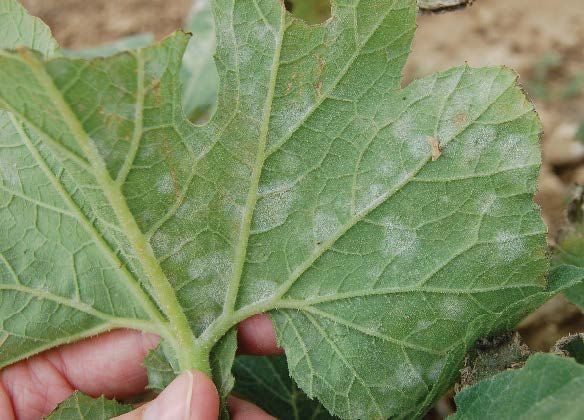
Credit: S. Zhang, UF/IFAS
Phytophthora Blight (Phytophthora capsici)
Phytophthora blight occurs sporadically, but is increasing in south Florida where warm and wet weather conditions are common. Since it is a soilborne disease, it has become a greater problem now that methyl bromide is no longer available. The fungal-like pathogen causes seed rot and seedling blight in many solanaceous and cucurbit crops, including many vegetable crops like tomato, pepper, eggplant, summer squash, cantaloupe, cucumber, pumpkin, and watermelon. In addition, foliar blight and fruit rot can also occur on mature plants, with symptoms varying by host species.
In summer squash, which is highly susceptible to this pathogen, initial symptoms include the development of water-soaked lesions that expand quickly on the leaves. Dieback of shoot tips, wilting, and shoot rot can be followed by rapid death of the entire plant (Figure 3, left). Fruit may develop dark, water-soaked areas and may be covered with the white growth of the pathogen (Figure 3, right). Disease development can be very rapid under warm and wet conditions, and entire plantings could be wiped out within several days despite the use of fungicides.
The fungal-like pathogen P. capsici survives in the soil or on host plant debris. Production of thick-walled spores (oospores) helps the pathogen to survive unfavorable time periods in the soil. The mobile spores (zoospores) are the type of pathogen to be spread by wind and water. Dissemination of this disease may also occur by moving contaminated soil or equipment. When surface moisture is present, zoospores landing on host plants can infect the plant tissue. Signs may be present in 3 to 4 days after infection under ideal conditions. Phytophthora blight develops rapidly in the presence of high rainfall and standing water, for which the disease is most severe at the lower locations in a field. While the pathogen can grow at temperatures from 46 to 99°F, the disease development is optimal at temperatures from 75 to 90°F.
Findings from studies in Florida showed greatest control from metalaxyl/mefenoxam when applied as a soil drench. However, resistance to these fungicides in P. capsici is widespread in Florida, therefore, management strategies have to be taken for resistance management. Metalaxyl/ chlorothalonil and metalaxyl/mancozeb drenches resulted in fair to good control, whereas drenches of etridiazole, etridiazole/thiophanate methyl, and fosetyl-aluminum provided inconsistent results. Recently, a few new chemistries, including fluopicolide and oxathiapiprolin (not registered yet), showed excellent control of this disease in south Florida.
Wet Rot (Choanephora cucurbitarum)
Wet rot, also called blossom rot, occurs every year in Florida, but in Miami-Dade County it occurs most severely during warm, wet periods of the year such as late spring or early summer. The disease primarily affects the flowers and fruits of squash. The fungus first starts on blossoms of summer squash and moves to the fruit, which turns dark at the blossom end, progressively moving throughout the fruit. The fungus covering the rotted area has the appearance of many black-headed pins, and the tissue underneath rots, particularly under moist conditions.
Additional vegetable crops affected by wet rot include okra, southern pea, and occasionally bean, pepper, and cucumber. Hibiscus, althea (Rose-of-Sharon), and cotton are additional hosts of this disease. Spores of the fungus can survive in soil and crop debris. The primary infection cycle on squash is thought to be initiated by wind dissemination of spores. Insects or wind may contribute to secondary spread of the disease. Within the squash crop, bees and striped and spotted cucumber beetles can transport the spores from one flower to another.
Viruses
Papaya Ringspot Virus Type W
Papaya ringspot virus type W (PRSV-W), a potyvirus formerly known as Watermelon mosaic virus 1, is the causal agent of a primary viral disease of squash in south Florida. While this disease does not occur every year, it may be widespread in some years. Its occurrence also depends on specific field conditions such as the presence of host plants near the field. In a particular year, some squash plantings may be virus-free, while others experience a severe infection.
Viruses on squash in Florida are common later in the season, primarily affecting older plants. Affected leaves of young plants may show chlorotic and mosaic symptoms, but older plants often experience mottling, stunting, and deformation of leaves. Fruits may become distorted and mottled in color.
Although leafminers have been shown to be capable of transmitting this virus, aphids are the primary vectors of PRSV. Aphids can spread PRSV from other cucurbit crops such as cucumber, watermelon, and cantaloupe, as well as weed hosts. Creeping cucumber (Melothria pendula) is a major weed host for this virus in south Florida, and balsam apple (Clusia rosea) and ivy gourd (Coccinea grandis) also harbor the virus. Implementing appropriate management programs against leafminers and aphids early in the planting season may delay and reduce disease incidence. Spraying insecticides to control the aphids that transmit the virus in cucurbit crops has proven futile. Aphids transmit these viruses in a stylet-borne, non-persistant manner, meaning that an aphid can pick up virus particles on its mouthparts (stylet) from an infected plant and transfer them to a healthy plant without the virus entering the aphid's body. This type of transmission can occur within seconds; therefore, insecticide sprays are ineffective in preventing virus spread because the aphids can still spread the virus before the insecticide kills the aphid. In fact, spraying insecticides for control of aphids may cause an increase in viral incidence by disturbing the aphids and increasing spread of the viruses. Meanwhile, many squash growers in Florida spray paraffinic oil (JMS Stylet Oil®) onto plants, which inhibits the attachment of the virus when aphids probe infected plants with their stylets. Managing vectors efficiently may reduce transmission of PRSV. Brief information on leafminers and aphid management practices are given below in the insect pest management section.
Zucchini Yellow Mosaic Virus
Zucchini yellow mosaic virus (ZYMV), another potyvirus that first appeared in Florida in 1981, now occurs sporadically throughout the state. Symptoms of infection appear between 7 and 12 days after inoculation and are similar to those of Papaya ringspot virus or Watermelon mosaic virus in squash. However, ZYMV can severely distort infected plants. The shape, size, and color of leaves and fruit can be greatly affected, with foliar symptoms appearing like herbicide (e.g., 2, 4-D) injury. As a result of infection, severe malformation and stunting of fruits may occur, and yields can be greatly reduced. ZYMV is also transmitted by aphids. The wild cucurbit creeping cucumber (M. pendula) is an important host and may be a reservoir of the virus.
Like other viruses transmitted by aphids, ZYMV is very difficult to control. Management of ZYMV primarily relies on resistant varieties because other measures, including insecticides, reflective mulches, and mineral oils, are largely ineffective.
Cucurbit Yellow Stunting Disorder Virus
Cucurbit yellow stunting disorder virus (CYSDV), a crinivirus in the family Closteroviridae, was originally reported in the Middle East and Spain. CYSDV was first detected in Florida in 2007. In the past two years, it has occurred more severely in the Homestead area due to the high population of whiteflies. CYSDV persists in the whitefly adult for up to 9 days, the longest time of any crinivirus. It affects all cucurbit crops, causing reduced fruit size and sugar content. Weeds, including pigweed, are plant hosts of CYSDV in Florida. Symptoms on squash include stunting of plant growth, leaf deformation, interveinal chlorosis in leaf tissues, and leaf mottling.
Managing the vectors and weed hosts of the virus are the only options for reducing losses at this time because no squash varieties resistant to these viruses are available. Whiteflies must feed on plants for some time in order to acquire enough virus for transmission, and this feeding period offers some window of opportunity to interrupt the transmission cycle with the application of insecticides. Reducing the overall population by controlling the immature stages of the whitefly, should also reduce virus spread. For viruses transmitted by the aphids, insecticide sprays are ineffective in preventing virus spread (such as PRSV-W) because the aphids spread the virus before the insecticide can kill the aphid. Cultural controls like sanitation, pre-planting cultural practices meant to avoid introducing the insect vectors or viruses, and post-planting practices like removing previous plants and weeds are essential for a strong resistance management program.
Tobacco Streak Virus
Tobacco streak virus (TSV), a member of the genus Ilarvirus, reported from more than 26 countries worldwide, has a wide host range, infecting over 200 plant species in 30 plant families. Cucurbits are among the hosts of TSV, including cucumber, bottle gourd, and pumpkin, with watermelon and squash being reported as experimental hosts. In the United States, TSV was first reported in Nicotiana tabacum from Wisconsin by Johnson (1936). Other natural hosts of TSV reported in the USA include asparagus, beans, clover, cowpea, and soybeans.
In 2014, using deep sequencing of small RNAs and assembly, a novel genotype of TSV was identified from zucchini squash grown in Miami-Dade County. Symptoms occurred on top young leaves: mosaic, leaf curling, yellowing, and stunting of plant tissues (Figure 5). These affected young leaves were usually small and distorted, showing narrow and pointed "fern leaf" symptoms. Although a strain of TSV was reported previously on cucurbits from a field survey in south Florida, the TSV strain (TSV_FL13-07) from Miami-Dade County represents an emerging novel genotype infecting squash in the United States with less than 90% sequence identities to other known US TSV isolates.
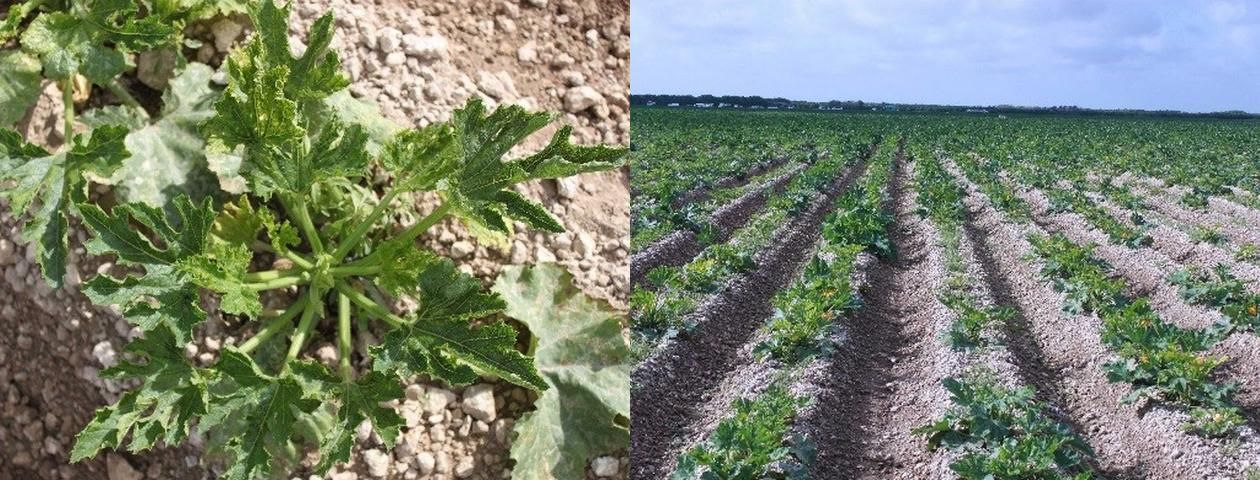
Credit: S. Zhang, UF/IFAS
TSV is efficiently transmitted in fields by thrips such as Frankliniella occidentalis and Thrips tabaci by mechanical means, and could be seed transmitted in some plant species. The existence of diverse genotypes of TSV with distinct serological reactivity and variable symptom expression makes it difficult to accurately diagnose the disease.
Control of TSV is difficult. It is always wise to use virus-free seed and to control weed hosts. Roughing infected plants at the early occurrence is helpful. Maintaining a good insect control program is advised, even though controlling the vectors alone will not provide sufficient control of TSV. Prompt destruction of crops after harvest is important, and the coordination with and cooperation of neighboring growers of thrips control sprays is critical to stopping the movement of thrips from infected fields.
Root-Knot Nematodes (Meloidogyne spp.)
Root-knot nematodes invade host plants when they are second stage juveniles and settle within the root to establish a feeding site. Secretions from the nematode cause the surrounding plant cells at the feeding site to enlarge and multiply, producing the galls characteristic of root-knot attack. The female nematode develops within the root, living for as long as several months and laying hundreds to several thousand eggs. Deformation of the roots results in symptoms that include leaf yellowing, plant stunting, wilting, and yield loss.
It is difficult to control root-knot nematodes by crop rotation of their wide host range of more than 2000 plant species. The use of soil fumigants to increase quality and yield of squash is always warranted because cucurbits are high cash value crops. Wherever available, resistant varieties should be planted because plant resistance is the most economical and environmentally safe measure for management of root-knot nematodes.

Credit: S. Zhang, UF/IFAS
Insect Management
Insect pests are one of the major constraints on growing squash and other cucurbits in Miami-Dade County. The tropical/subtropical climate prevails year-round and encourages insect pests. Insects attack squash from planting to harvest with consequent insecticide control costs of $1.13 million annually. Among the insect pests, silverleaf whitefly, melonworm, pickleworm, melon thrips, American serpentine leafminer, aphid, broad mite, cucumber beetle, and wireworms are common in Miami-Dade County and cause economic damage to squash and other cucurbits. Brief information about the detection and management of insect pests that cause economic damage to squash and other cucurbits in Miami-Dade County is given below.
Silverleaf Whitefly (SLW), Bemisia argentifolii Bellows and Perring
This is the most common insect pest attacking foliage of squash and other cucurbits. Sufficient numbers of adults and immatures may cause death of young squash plants. Attacks at the late growth stage may cause severe economic loss due to a reduction of plant vigor. Adults and nymphs secrete honeydews, which leads to the production of sooty molds. Silverleaf whitefly is a potential vector of several commonly occurring viruses in cucurbits, which are discussed above in the disease management section.
Management Program
Detection
The beginning of SLW infestation can be detected in the crop field by using yellow sticky cards and by directly checking the under surface of the squash leaf. Management programs should be started when the number of adults/sampling leaf exceeds two.
Cultural Control
1) keep crop fields free of weeds; 2) do not place a host crop within 500 ft of an infested crop; 3) avoid growing other host crops during summer to break the life cycle of SLW; 4) UV- reflecting (metalized) mulch repels whiteflies early in the crop; 5) appropriate live mulch (e. g., peanut) can be used to reduce the reproduction of SLW; 6) immediately disk fields to kill immatures and to stop reproduction.
Chemical Control
See Table 4. Use neonicotinoid insecticides (Admire, Platinum) at planting as a soil application and then spray other effective insecticides on foliage. Always avoid using insecticides in the same class on successive generations.
Melonworm and Pickleworm
Melonworms (Diaphania hyalinata Linnaeus) and pickleworms (Diaphania nitidalis (Stoll)) are the most important pests of squash and other cucurbits. Melonworms have a white strip down the side except in the first and last instar. Wings of adults are white with black border. Larvae first feed on foliage before sometimes defoliating a crop and entering the fruits. Pickleworms can first be found in flowers but later in fruits. They are cream colored with dark spots when small but later become pale green and lose their spots. Adults are brown with a central yellow spot on the fore wing and yellow base on the hind wing. Melonworms tend to be most abundant in fall and pickleworms in spring, but either can occur throughout the season.
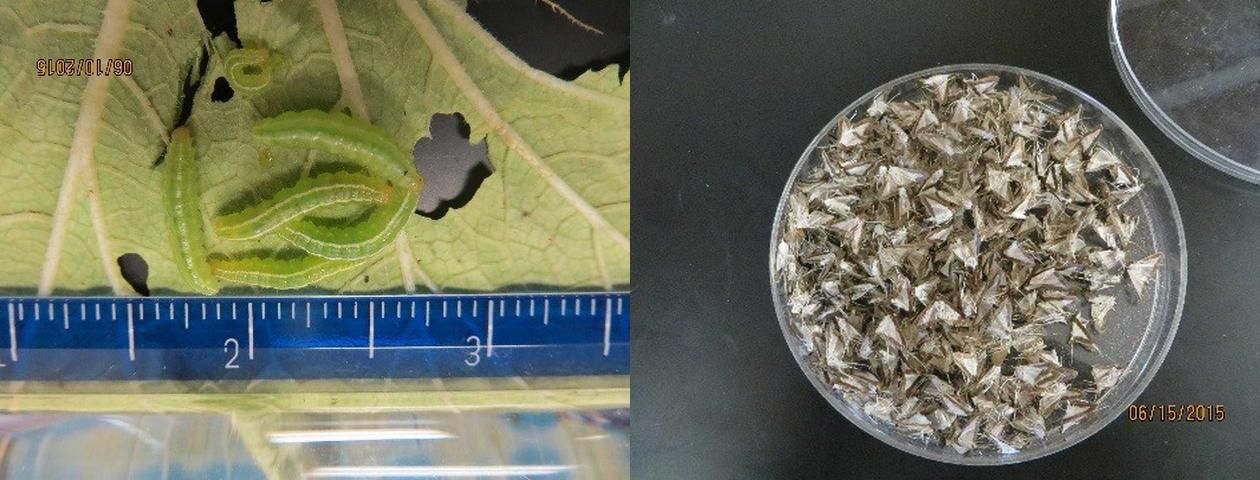
Credit: D. Seal, UF/IFAS
Management Program
Management of melonworms and pickleworms can be accomplished by timely detection of the pest and by using cultural, biological, and chemical control in a timely manner.
Detection
The presence of melonworms and pickleworms can be detected by using pheromone traps. Their presence can also be detected by looking for feeding holes on the leaves.
Biological Control
There are various native predators that feed on eggs and the early stage of melonworms and pickleworms. Among these, minute pirate bug, milkweed assassin bug, and lacewing larvae are the important ones. Bacillus thuringiensis (Bt) based insecticides are effective in controlling melonworms and pickleworms and are compatible with predators and parasitoids. The biological insecticides can be used in a program to manage these worms.
Cultural Control
The above mentioned cultural control practices for SLW can be used to reduce melonworms and pickleworms populations.
Chemical Control
Best control of melonworms and pickleworms can be achieved with insecticides that specifically target Lepidoptera. See Table 4.
Melon Thrips, Thrips palmi Karny
Melon thrips arrived in Miami-Dade Country in 1990 and caused defoliation of squash, cucumber, beans, pepper, eggplants, and okra. Later, it spread to Broward, Palm Beach, and Collier Counties. Melon thrips occur in all seasons when a proper host crop is available. However, peak abundance of melon thrips is usually observed from December to May. Larvae and adults on the undersurface of the leaves feed on the epidermal layer. Adults of melon thrips and other species can also be found in blooms. Melon thrips developed resistance to various groups of chemical insecticides. Management of melon thrips is based on cultural practices meant to increase predatory bugs (minute pirate bugs, lady beetles, lace wing bugs) and proper use of effective chemicals, such asspinetoram (Radiant), cyazypyr (Exirel), and abamectin (Agrimek).
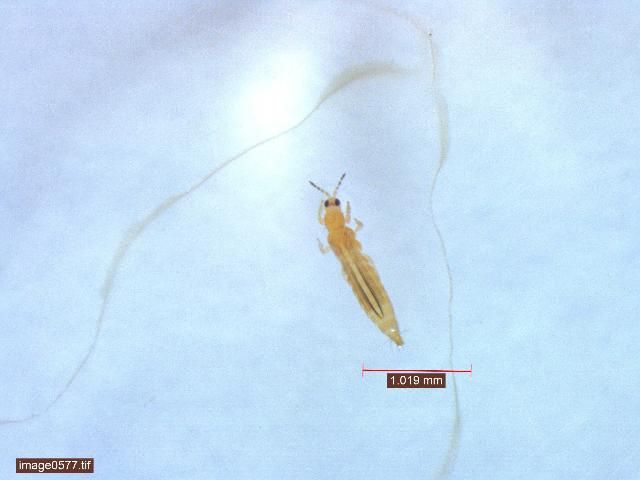
Credit: D. Seal, UF/IFAS
Management Program
Detection
Presence of melon thrips can be detected by using sticky cards of various colors although yellow sticky cards were found to be more effective. Thrips presence can also be confirmed by visually checking various plant parts. Beating plant parts against a letter size white board dislodges thrips adults and larvae, which can then be counted. Leaf washes with 70% alcohol provide a more accurate count.
Biological Control
Various predatory mites feed on melon thrips adults and immatures; in particular, Amblyseius swirskii is a potential predator and can be purchased commercially. Minute pirate bug adults and immature stages feed on all development stages of melon thrips. Paecilomyces fumosoroseus, Verticillium lecanii, and Beauveria bassiana may cause reduction of melon thrips but not a significant enough reduction to save a crop from a heavy infestation. Entomopathogenic nematodes have a potential to suppress melon thrips in a favorable environmental condition (proper soil moisture).
Cultural Control
The various cultural control methods discussed in the SLW section can be used to reduce population abundance of melon thrips. Postharvest disking of crops kills all stages of melon thrips and reduces the buildup of populations in nearby crops.
Chemical Control
See Table 4. Use effective chemicals in a rotation program. Add sticker, spreader, or nonionic surfactant with insecticides to obtain sufficient coverage on the treated area.
Leafminers, Liriomyza trifolii (Burgess)
The vegetable leafminer, Liriomyza trifolii Burgess, is an economic pest of squash and other cucurbits. It also feeds on other crops. The early seedling stage is most attractive for the leafminers. In absence of any proper control methods, the whole crop may be defoliated within a week of infestation. Leafminer feeding and oviposition punctures may allow sap contents of the leaf to ooze out, rendering the leaf weak and resulting in death. Injuries caused by leafminer adults and immatures can become entry points for bacterial and fungal pathogens. Populations peak on fall and spring plantings and remain low the rest of the year.
Management Program
Detection
Yellow sticky traps can be placed in the crop fields to detect arrival of leafminers. The upper surface of host leaves can be checked carefully for stipples and mines.
Biological Control
Natural biocontrol agents play a significant role in suppressing leafminer population. Thirteen species of wasp parasitoids were found active in vegetable crops against leafminers. Opius dissitus Muesebeck was the most abundant parasitoid throughout vegetable seasons followed by Diaulinopsis callichroma (Crawford). Avoid use of broad-spectrum insecticides like pyrethroids, organo-phosphates, and carbamates to conserve natural enemies. Entomopathogenic nematodes were found to cause mortality of pupae both on leaves and in soil.
Cultural Control
Various cultural practices described above can be adopted to suppress leafminers populations. Postharvest disking to bury all larvae and pupae significantly reduces adult emergence.
Chemical Control
See Table 4. Soil application of Vydate®, Platinum®, and Coragen® at planting significantly reduces leafminer populations early in the season. Use other effective insecticides in rotation late in the season if necessary.
Aphid, Myzus persicae (Sulzer); Aphis gossypii Glover
Green peach aphid and melon aphid are polyphagous pests feeding on 40 plant families over a wide geographical range. They occur all over North America, attacking plants grown in the field and in greenhouses.. In field studies, maximum aphid populations can be observed at peak plant canopy. They occur more often on the lower leaves of a mature plant than on the top leaves. Viviparous or live young production predominates in south Florida; oviparous or egg production is rare. Aphids at a high population level smother young foliage, resulting in wilting and reduced growth rate. These and other aphid species transmit viruses such as Papaya ringspot virus type W and Zucchini yellow mosaic virus, which are discussed above in the disease management section. Aphid species that do not actually colonize squash can bring the virus into the field (primary spread) or spread it within the field (secondary spread) simply by probing the plant. The incidence of virus infection may be low at the beginning but spread rapidly due to handling during harvest, which disturbs the aphids causing them to move. In a severe case, up to 90% of squash plants can be infected with the virus.

Credit: D. Seal, UF/IFAS
Management Program
Detection
Aphids can be detected on yellow sticky cards, which are yellow plastic boards of variable sizes (6–8 sq. in) covered with tanglefoot to trap insects. Four to six yellow sticky cards can be placed on each side of a crop field to record initial infestation. The infestation of aphids can also be confirmed by visually checking squash leaves. Aphids produce honeydew, which is a sugary liquid waste. Sooty mold can grow on honeydew, turning the leaf black—a clear indication of aphid infestation.
Biological Control
Generalist predators, such as minute pirate bugs, lacewing larvae, and lady bugs may provide suppression of aphids at low population density. Populations of predators can be conserved by avoiding broad-spectrum insecticides. Various fungal-based insecticides, such as Paecilomyces fumosoroseus, Beauveria bassiana, and Metarhizium anisopliae, are also effective in reducing aphid population.
Cultural Control
Aphids can be controlled by using multiple approaches in a timely manner. Weed-free crop fields may have fewer aphids than weedy fields. High moisture in the plant canopy for lengthy periods increases aphid populations. Varieties resistant to aphid born viruses should be used in a field with a history of high incidence. All other practices described in the SLW section can be used to reduce aphid populations.
Chemical Control
See Table 4. It is important to note that insecticide sprays may be ineffective in preventing virus spread since the aphids can spread the virus before the insecticide kills them due to the non-persistent nature of the aphids. Spraying insecticides to control the aphids for transmitting PRSV-W in cucurbit crops has proven unsuccessful. However, effective insecticide should be used at the beginning of aphid infestation to avoid population increase.
Broad Mite, Polyphagotarsonemus latus (Banks)
Broad mite is a minute arthropod of about 0.1–0.3 mm long. It is not a common pest of cucurbits. It can occasionally infest squash and other cucurbit plants. Broad mites can occur on the youngest leaves of squash plants, stunting growth by secreting toxic saliva. Leaf distortion and stunting can cause yield loss.
Management Program
Detection
Broad mites can be detected by looking at the stunted leaves at the tip of a plant. They are tiny and difficult to see with the naked eye, but a hand lens at 10X magnification can be used to detect them on very young host foliage.
Biological Control
A number of generalist predatory mites show potential in suppressing broad mites. Neoseiulus californicus (McGregor) and Neoseiulus barkeri (Hughes) have been reported to provide adequate control of mites on various host crops. Amblyseius swirskii (Athias-Henriot) provided good control of broad mites on pepper. Fungal pathogens, such as Paecilomyces fumosoroseus, Beauveria bassiana, and Metarhizium anisopliae may provide suppression of broad mites on squash and other crops.
Cultural Control
Various weed species are considered as potential hosts of broad mites. Fields should be kept free from weeds. Avoid planting new crops near the infested fields which will enhance broad mites in the new fields. Barriers around the crop field may reduce introduction of broad mites by some flying insects. Also, other cultural control methods discussed in the SLW section can be used for managing this pest.
Chemical Control
See Table 4. Pyrethroids are harmful to the natural biocontrol agents. Use of pyrethroids may increase broad mite populations on squash and other crops. Oil and soap can reduce broad mite populations.
Cucumber beetle, Diabrotica spp.
Cucumber beetle is a common pest of various vegetable crops. The adults feed on foliage and can defoliate squash and cucumber plants in the absence of any control measures. The larvae are known as corn rootworm and feed on roots of squash and other crops. They can occur in two forms—striped (western corn root worm, Acalymma vittata (Fab.)) and spotted cucumber beetles (southern corn root worm, Diabrotica undecimpunctata howardii Barber). Adult cucumber beetles harbor bacteria that cause wilt in cucumbers.
Management Program
Detection
Cucumber beetles can easily be recognized by the naked eye. They are fast fliers and move from plant to plant. Yellow sticky cards can be used to trap them.
Biological Control
Various small birds that inhabit in the crop field were reported to be excellent biocontrol agents of this pest. Small bats were reported to feed on cucumber beetles. Entomopathogenic nematodes provide suppression of corn root worms.
Cultural Control
Sweeping or vacuuming infested plants reduces adults significantly. Aluminum coated plastic mulch repels adults and keeps population low. Trap crops can be placed at the vicinity to divert adults away from the main crop.
Chemical Control
See Table 4. The application of Coragen® at planting provides long lasting control of cucumber beetles. Novaluron and pyrethroids are effective in managing cucumber beetles.
Wireworm
Wireworms are the larvae of click beetles. They are soil pests that feed on plant roots and other underground parts of a plant. Wireworms attack squash seeds at germination phase to feed on seed contents. Sweet potato and Irish potatoes are preferred hosts of wireworm. Conoderus amplicollis (Gulf wireworm) prefer sweet corn fields. C. scissus prefers peanuts. C. rudis prefers germinated seeds of all vegetable crops. Melanotus communis Gyllenhal (corn wireworm) prefers corn and sugarcane. They can cause significant economic loss to the host crops in the absence of proper cultural control.
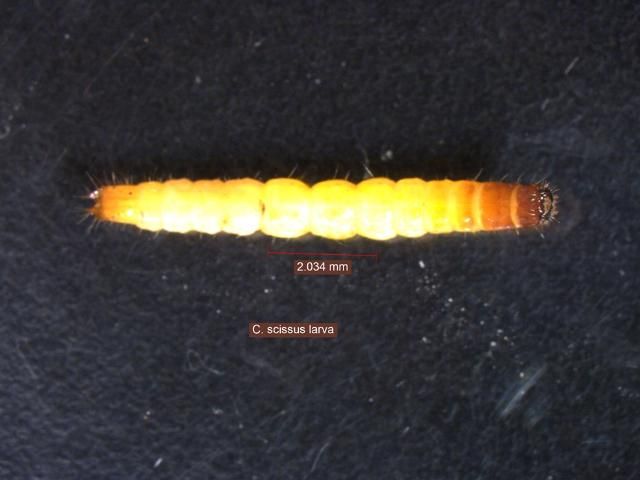
Credit: D. Seal, UF/IFAS
Management Program
Detection
Adults can be trapped using a black light trap. Pitfall traps can be used to catch adult click beetles. Yellow sticky cards can be placed in crop fields to detect adult flights. On the other hand, wireworms can be caught by using seed baits of various types, where decomposed baits 10–12 days after planting attract wireworm larvae from a distance of three feet from the bait station. Most commonly used baits for attracting wireworms are: wheat, corn, sorghum-sudangrass seeds, and potato seed pieces.
Biological Control
Birds feed on surface-living wireworms. Entomopathogenic nematodes infect wireworm larvae. Various fungal pathogens cause death to wireworms.
Cultural Control
Disking fields repeatedly brings wireworms to the surface, causing desiccation and death. Flooding a field for 2–5 days causes suffocation and death of larvae. Crop rotation causes significant reduction in wireworm populations. Intercropping with non-host crops reduces wireworm damage on the host crop.
Weed Management
Weeds compete with the squash for water and nutrients and can complicate harvest.
An integrated weed management program can reduce the number of weeds in squash. This includes preventative, cultural, and mechanical weed control methods. Herbicides remain the primary method of weed control in conventional squash production. Weeds and their control can be separated into nutsedge, broadleaf, and grass weeds.
During the fallow period, use a program that includes cultivation to break apart the chains of nutsedge tubers, followed by glyphosate 4 weeks later to control tuber growth. An application of glyphosate before cultivation may also need to be included. Planting cover crops during the fallow period is also an option. Nutsedge and other weeds do not grow well in shade so a quick-growing cover crop and narrow row spacing are important for quickly shading the soil surface.
Plastic mulches also inhibit the growth of grass and broadleaf weeds. Plastic mulches do not provide control of nutsedge; thicker mulches will slow the growth of nutsedge. Dimethyl disulfide is a fumigant that provides the greatest control of nutsedge among the fumigants currently on the market. Dimethyl disulfide does not control grass and certain broadleaf weeds so an herbicide is required for control of these weeds. The fumigant 1,3 dicholoropropene and chloropicrin can provide some control of nutsedge; however, results are inconsistent. Virtually impermeable film and totally impermeable film (TIF) will retain the fumigant for a longer period of time than low density mulches, which will improve the control from fumigation.
Nutsedge (Cyperus rotundus and Cyperus esculentus)
Purple nutsedge (Cyperus rotundus) is the primary type of nutsedge in the Homestead area (Figure 11); however, yellow nutsedge is also present in some fields. With the phaseout of methyl bromide, nutsedge has become more problematic in the last 10 to 15 years. For control of nutsedge, multiple control methods are absolutely required.
Sandea® is the only herbicide registered in squash for control of nutsedge. Sandea® at 0.5 to 1.0 oz/acre can be applied only to the row middles and has a 30 day preharvest interval.
Glyphosate can be applied during the fallow period or before transplanting. If glyphosate is applied over the top of the plastic before planting, then the plastic must be washed with irrigation or rainfall.
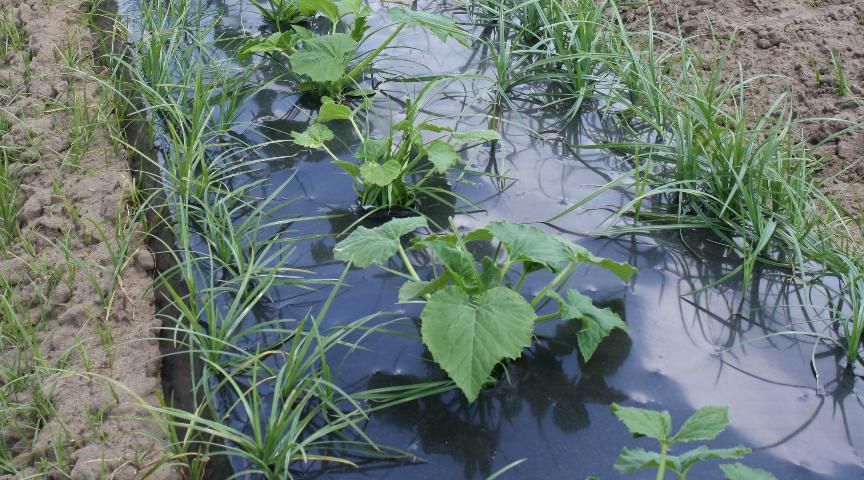
Credit: Peter J. Dittmar, UF/IFAS
Grasses
Multiple grass species are problematic in squash. Preemergence control of grass weeds can be achieved with Prefar® and Command®. In the Homestead area, performance is sporadic due to the soil type. Postemergence control of grasses can be achieved with clethodim (Arrow®, Clethodim™, Select Max®, others) or clethodim (Poast®). These herbicides control only grass weeds and will not injure the squash plants. If injury does occur, this is the result of using a crop oil concentrate. During periods of extreme heat or high humidity use a nonionic surfactant or no surfactant according to the label recommendations.
Broadleaf Weeds
Broadleaf weeds in squash are difficult to control because of the lack of herbicide options. Preemergence control of broadleaf weeds can be achieved with Prefar® and Command®. In the Homestead area, performance is sporadic due to the soil type. No herbicide is labeled for postemergence control of the broadleaf weeds. If glyphosate is being used during the fallow period, ragweed Parthenium has been identified as resistant and may not be controlled with an application of glyphosate. Incorporate paraquat or diquat into rotation for control of the ragweed parthenium.
For individual herbicide recommendations, review the Vegetable Production Handbook for Florida https://edis.ifas.ufl.edu/entity/topic/vph. The tables are separated by herbicides that should be applied before planting or before germination (pretransplant /premergence) and herbicides that may be applied after transplanting or crop emergence (posttransplant/postemergence). Use the lower rates of preemergence herbicides because of the low organic content of the calcareous soils.
Harvest
The harvest season extends from October into April. Squash is hand-picked.
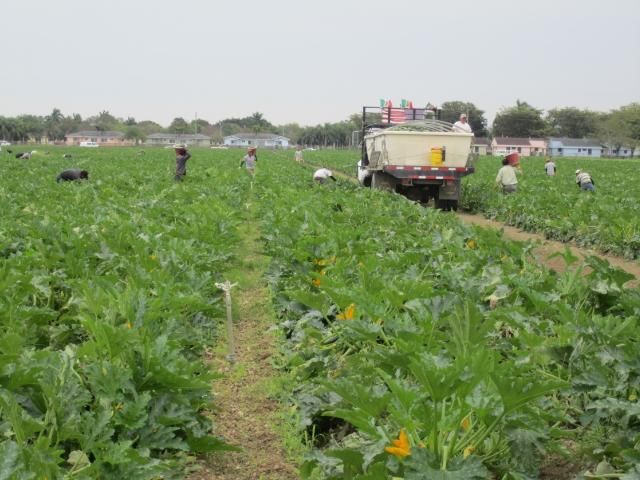
Credit: Monica Ozores-Hampton, UF/IFAS
Multiple Cropping/Rotation
Squash is often used as a second crop after tomato and eggplant on plastic mulch and can be rotated with bean or okra on flat ground. There is risk in rotating cucurbits with solanaceous crops because of Phytophthora blight. This disease is caused by Phytophthora capsici, which develops explosively in moist conditions and produces large numbers of infective sporangia and has a wide host range as described above. The disease is very damaging and difficult to control.
References
Hochmuth, G., D. Maynard, C. Vavrina, E. Hanlon, and E. Simonne. 2012. Plant Tissue Analysis and Interpretation for Vegetable Crops in Florida. (HS964). Gainesville: University of Florida Institute of Food and Agricultural Sciences. https://edis.ifas.ufl.edu/ep081
Johnson, J. 1936. Tobacco streak, a virus disease. Phytopathology 26: 285.
Uchida, R. 2000. "Recommended Plant Tissue Nutrient Levels for Some Vegetable, Fruit, and Ornamental Foliage and Flowering Plants in Hawaii." In J. A. Silva and R. Luchida (Eds). Plant Nutrient Management in Hawaii's Soils, Approaches for Tropical and Subtropical Agriculture. College of Tropical Agriculture and Human Resources, University of Hawaii at Menoa. https://www.ctahr.hawaii.edu/oc/freepubs/pdf/pnm4.pdf
Values for macro nutrients in yellow squash and zucchini measured from the most-recently-matured whole leaf plus its petiole (MRML) unless otherwise noted (Hochmuth et al. 2012; Luchida 2000).